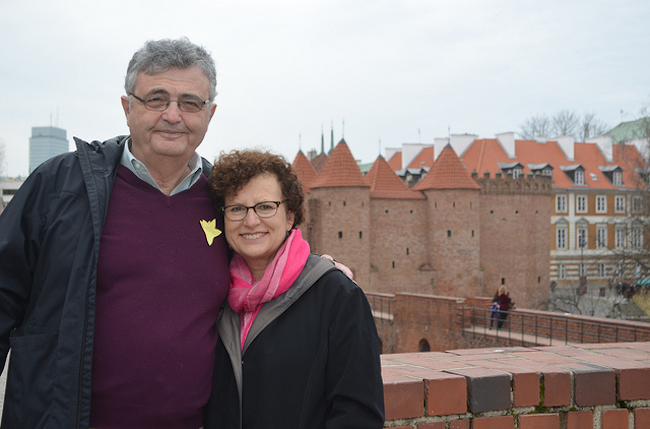 HARTFORD, CT, May 9, 2013 – Since the 2007 publication of Who Will Write Our History? Emanuel Ringelblum, the Warsaw Ghetto, and the Oyneg Shabes Archive, Samuel Kassow, Charles H. Northam Professor of History at Trinity, has won numerous awards, been elected a Fellow of the American Academy for Jewish Research, lectured often and widely, and been recognized as one of the world’s leading scholars on the Holocaust and more specifically, the fate of Jews in Poland. Just last month, Kassow was invited to Warsaw to commemorate the 70th anniversary of the Warsaw Ghetto uprising and was asked to speak at the unofficial opening of the Museum of the History of Polish Jews. The five-day event, April 18-22, was somber yet uplifting and featured a number of dignitaries and notable organizations, including the president of Poland, Bronislaw Komorowski; the Israeli Philharmonic and conductor Zubin Mehta; philanthropic organizations; human rights activists; scholars; and Simcha Rotem, one of the last survivors of the ghetto uprising. “It was really, really amazing,” said Lisa Kassow, director of Trinity Hillel and Sam’s wife. “The anniversary of the Ghetto uprising overtook the entire city. There was nothing else going on. Everywhere you turned, there were advertisements about events and Jewish issues.””
HARTFORD, CT, May 9, 2013 – Since the 2007 publication of Who Will Write Our History? Emanuel Ringelblum, the Warsaw Ghetto, and the Oyneg Shabes Archive, Samuel Kassow, Charles H. Northam Professor of History at Trinity, has won numerous awards, been elected a Fellow of the American Academy for Jewish Research, lectured often and widely, and been recognized as one of the world’s leading scholars on the Holocaust and more specifically, the fate of Jews in Poland. Just last month, Kassow was invited to Warsaw to commemorate the 70th anniversary of the Warsaw Ghetto uprising and was asked to speak at the unofficial opening of the Museum of the History of Polish Jews. The five-day event, April 18-22, was somber yet uplifting and featured a number of dignitaries and notable organizations, including the president of Poland, Bronislaw Komorowski; the Israeli Philharmonic and conductor Zubin Mehta; philanthropic organizations; human rights activists; scholars; and Simcha Rotem, one of the last survivors of the ghetto uprising. “It was really, really amazing,” said Lisa Kassow, director of Trinity Hillel and Sam’s wife. “The anniversary of the Ghetto uprising overtook the entire city. There was nothing else going on. Everywhere you turned, there were advertisements about events and Jewish issues.””
“About 3.3 million Jews lived in Poland at the outbreak of World War II, although in 2011 only about 7,500 Poles identified themselves as Jews. Nonetheless, the Warsaw Ghetto and Poland’s pre-war Jewish population is still inextricably linked with Polish history.The symbol of the April remembrance was the daffodil, which came to represent respect and hope in the Ghetto. The brilliant yellow flowers were everywhere, blooming as they do in April, the month that launched the Ghetto uprising. During the recent event, volunteers distributed paper daffodils to the citizens of Warsaw and the many visitors, encouraging them to pin the flowers to their clothes in memory of the uprising. The Warsaw Ghetto uprising began on April 19, 1943 when the German military entered the Ghetto with the intention of “liquidation” – the deportation of all residents, mostly Jews, to forced labor camps. The residents chose to resist rather than be deported to the camps, where death awaited them. The Jews continued to fight for 28 days, though greatly outnumbered and lacking weapons. By May 16, thousands of Ghetto fighters were captured or killed and the Germans proceeded to destroy the Ghetto.”
READ ENTIRE ARTICLE HERE.
SEE MORE PHOTOS HERE.

